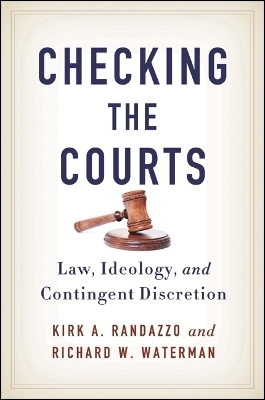
Checking the Courts
State University of New York Press (Verlag)
978-1-4384-5287-6 (ISBN)
How does the language of legislative statutes affect judicial behavior? Scholars of the judiciary have rarely studied this question despite statutes being, theoretically, the primary opportunity for legislatures to ensure that those individuals who interpret the law will follow their preferences. In Checking the Courts, Kirk A. Randazzo and Richard W. Waterman offer a model that integrates ideological and legal factors through an empirical measure of statutory discretion. The model is tested across multiple judicial institutions, at both the federal and state levels, and reveals that judges are influenced by the levels of discretion afforded in the legislative statutes. In those cases where lawmakers have clear policy preferences, legislation encourages judges to strictly interpret the plain meaning of the law. Conversely, if policy preferences are unclear, legislation leaves open the possibility that judges will make decisions based on their own ideological policy preferences. Checking the Courts thus provides us with a better understanding of the dynamic interplay between law and ideology.
Kirk A. Randazzo is Associate Professor of Political Science at the University of South Carolina and author of Defenders of Liberty or Champions of Security? Federal Courts, the Hierarchy of Justice, and U.S. Foreign Policy, also published by SUNY Press. Richard W. Waterman is Professor of Political Science at the University of Kentucky and the author of several books, including The Changing American Presidency: New Perspectives on Presidential Power.
List of Illustrations
Acknowledgments
1. Introduction
Anecdotal Evidence of Statutory Influence on Judges
Systematic Statutory Influences on Judicial Behavior
Measuring Legal Factors
Organization of the Book
2. Theoretical Foundations
Approaches to Interpretation and the Canons of Statutory Construction
Separation of Powers Models
Influence of Law and Ideology on Judicial Behavior
Placing Judicial Decision Making into a Broader Theoretical Context
The Model of Contingent Discretion
Operationalization of Statutory Discretion
Conclusions
3. U.S. Courts of Appeals
Historical Development of the Federal Appellate Courts
Anecdotal Evidence from Appeals Court Judges
Empirical Analysis of Statutory Influence
Circuit-Specific Analyses of Statutory Influence
An Alternative Specification
Conclusions
4. The U.S. Supreme Court
Historical Development of the Supreme Court
Anecdotal Evidence from Supreme Court Justices
Empirical Evidence Analysis of Statutory Influence
Justice-Specific Analyses of Statutory Influence
An Alternative Specification
Examination of Statutes Under Judicial Review
Corollary Analysis of Statutes and Unanimous Decisions
Conclusions
5. State Supreme Courts
Influence of Law and Ideology on State Supreme Courts
Anecdotal Evidence from State Court Judges
Empirical Analysis of Statutory Influence
Corollary Analysis of Statutes and Judicial Elections/Appointments
Conclusions
6. Temporal Analysis of Supreme Court Behavior
The Temporal Nature of the Law
Evolution of Congressional Statutory Language
Empirical Analysis of Statutory Influence versus Judicial Annotations
Corollary Analysis of Statutes and Unanimous Decisions
Conclusions
7. Toward a New Paradigm
Summary of Empirical Evidence
Theoretical and Substantive Implications
Important Caveats
Remaining Questions
Appendix
Notes
References
Index
| Erscheint lt. Verlag | 1.9.2014 |
|---|---|
| Reihe/Serie | SUNY series in American Constitutionalism |
| Zusatzinfo | Total Illustrations: 42 |
| Verlagsort | Albany, NY |
| Sprache | englisch |
| Maße | 152 x 229 mm |
| Gewicht | 490 g |
| Themenwelt | Recht / Steuern ► EU / Internationales Recht |
| Recht / Steuern ► Öffentliches Recht ► Verfassungsverfahrensrecht | |
| Recht / Steuern ► Privatrecht / Bürgerliches Recht ► Zivilverfahrensrecht | |
| Sozialwissenschaften ► Politik / Verwaltung ► Staat / Verwaltung | |
| ISBN-10 | 1-4384-5287-X / 143845287X |
| ISBN-13 | 978-1-4384-5287-6 / 9781438452876 |
| Zustand | Neuware |
| Informationen gemäß Produktsicherheitsverordnung (GPSR) | |
| Haben Sie eine Frage zum Produkt? |
aus dem Bereich


